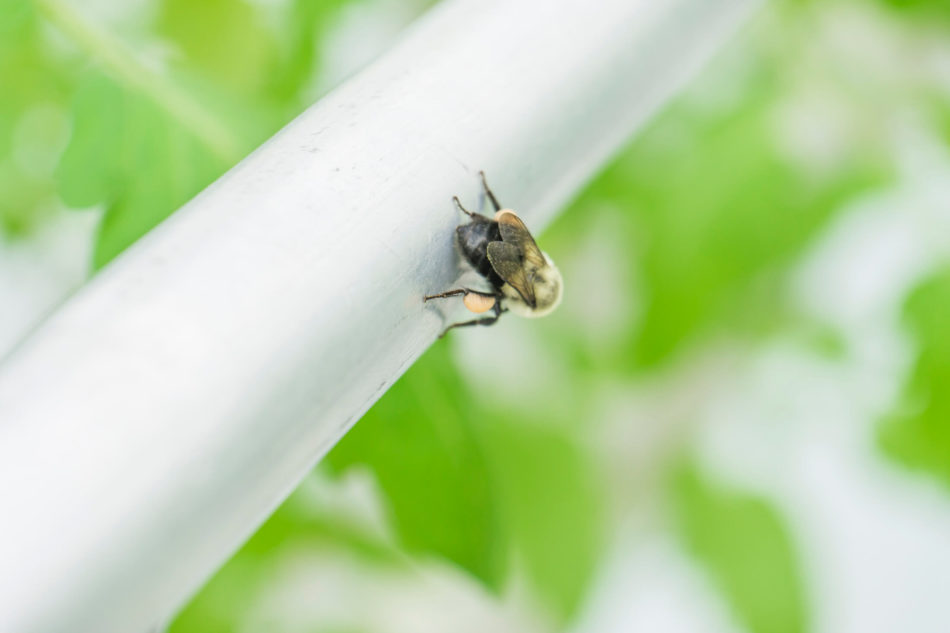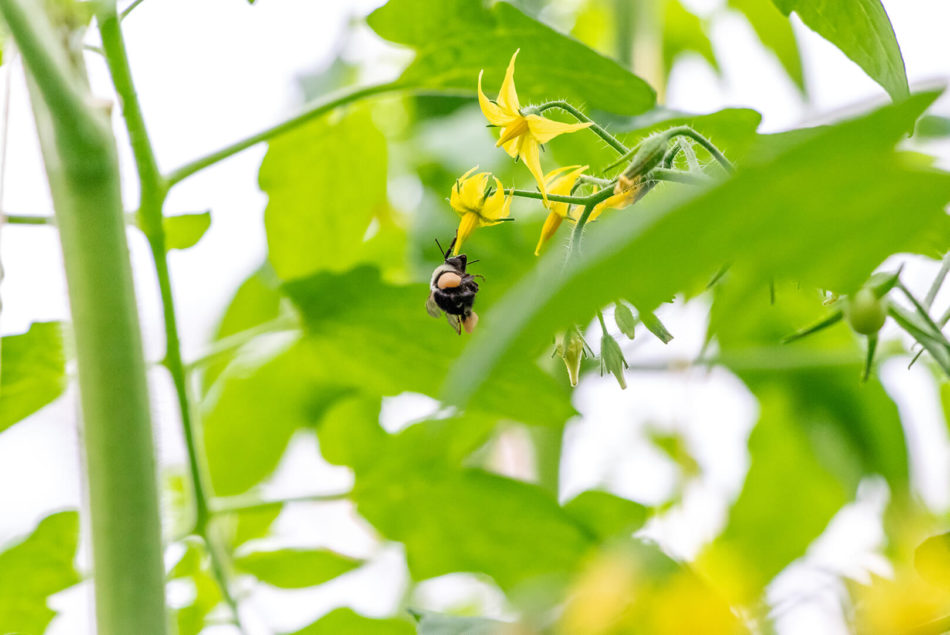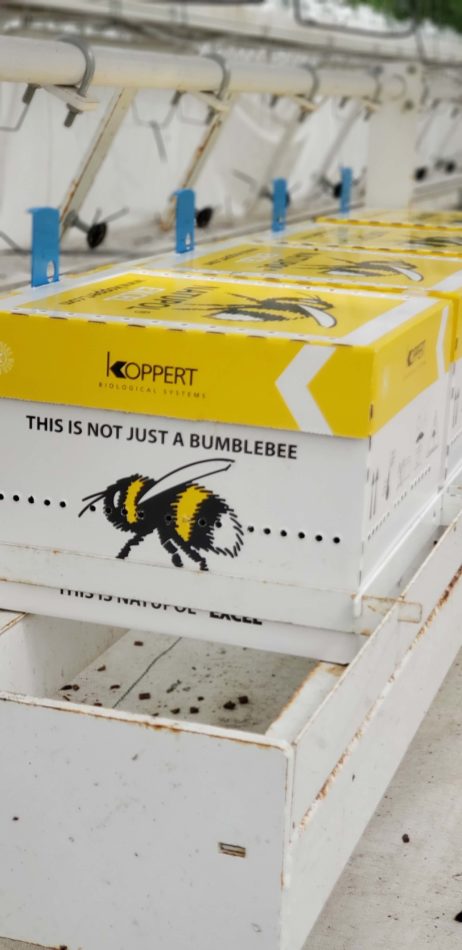Why Are Bumble Bees So Important?
Bumble Bees, along with hundreds of other insects and small animals like butterflies and birds, play an incredibly important role in our world. They are natural pollinators, which means they ensure pollination occurs for plants all over the globe!
When it comes to crop production, the process of pollination is necessary for all plants to produce fruit. While some plants are self-pollinating, which means they transfer pollen independently, many plants do need natural pollinators to perform the act of pollination for them so that their flowers can mature. One plant that relies heavily on Bumble Bees for pollination is the Tomato plant!

In any one of our Tomato greenhouses, you will find thousands of Bumble Bees flying from plant to plant, pollinating Tomato flowers as they go. From sun-up to sun-down, our Bumble Bees are hard at work helping our plants grow healthy, flavorful Tomatoes.
Let’s take a closer look at these powerhouse pollinators – it won’t take long to see just how important they are to the success of our Tomato crops!
How Does Pollination Work?
When looking specifically at a Tomato plant, pollination is defined as the transfer of pollen from a part of the Tomato flower called the stamen to another part of the flower called the pistil. Bumble Bees are excellent at transferring pollen from flower to flower because pollen sticks well to their fuzzy bodies. When a Bumble Bee visits a flower to eat its nectar, the Bumble Bee’s fuzzy body picks up pollen in the process and spreads it to the next flower it visits, or even to the same flower – and on and on it goes.

Every week, our Bumble Bees can pollinate over 10 million Tomato flowers in one 30-acre greenhouse! A Bumble Bee’s accuracy rate is just shy of 100%, meaning they are almost perfect at ensuring every single Tomato flower in our greenhouses is pollinated. Although manual pollination can be done by humans, the numbers speak for themselves: Bumble Bees are much more efficient and accurate at pollinating than we could ever hope to be!
Although we could use other types of insects for pollinating, we choose to use Bumble Bees (specifically the bombus terrestris Bumble Bee species) for a few important reasons:
- Bumble Bees are less aggressive than other types of bees. Although we have people working closely with our Bumble Bees in the greenhouse, it is very unlikely that they will be stung by them.
- Honey Bees are long-range fliers, whereas Bumble Bees tend to stay close to home. This makes Bumble Bees a better option as we need them to continuously pollinate within the same greenhouse.
- This specific species has been extensively researched by Bumble Bee breeders and they have determined that it is one of the most efficient pollinators in our region!
Just like with our beneficial bios (also known as good bugs), the Bumble Bee species we have in our greenhouses are native to North America. This means that they are not an invasive species, so if any of our Bumble Bees find their way out of the greenhouse, they will not pose any threat to other native insects in our region.
Depending on the Tomato variety, we need to introduce a different amount of Bumble Bees to the greenhouse environment. Smaller Tomato varieties like Cherry Tomatoes or Tomberry® Tomatoes have many more flowers than larger varieties like Beefsteak Tomatoes, which means they need more Bumble Bees per acre to properly pollinate.
Our Bumble Bee Team
Where do we get all these hardworking Bumble Bees, anyway? There are a few Bumble Bee breeders in our region that regularly supply local greenhouses like Nature Fresh Farms with boxed Bumble Bee hives specifically for crop pollination. Depending on the variety, we will receive 12-20 hives per week from our Bumble Bee breeders.
When we introduce new hives to the greenhouse, we place them underneath our gutters and elevate them off the greenhouse floor. This is the perfect spot for our hives because they remain shaded from the sun, keeping our Bumble Bees cool enough to still be able to work comfortably. Although we have multiple hives in one row, and dozens of hives throughout one greenhouse, it amazes us that our Bumble Bees can almost always find their way back to their home hive!

In each hive, there is one Queen Bee and a colony of Worker Bees. You can tell which insect is the Queen Bee by her size – she is roughly three times larger than all the other Bumble Bees! The Queen Bee stays in the hive for her entire life cycle to grow the colony while the Worker Bees leave the hive to search for food (and pollinate our flowers in the process). When they arrive at the greenhouse, each hive has anywhere from 50 to 80 Bumble Bees inside, but the colony will grow during its time at our farm.
Each Bumble Bee hive is equipped with a sugar water tank that the Bumble Bees can access, as well as holes for them to enter and exit the hive. Tomato plants don’t produce enough natural nectar for our Bumble Bees to feed off of, so the sugar water tank is made readily available for them as a supplemental food source. The entrance and exit holes are also a special part of the boxed hive: in the evening, we can reposition the holes so that the Bumble Bees can only enter the hive, but not leave it. This is important because Bumble Bees only work from sun-up to sun-down – they can’t fly in the dark! Our team keeps the holes closed from dusk until first light when the Bumble Bees can safely leave their hives and properly navigate the greenhouse environment.
Our Bumble Bees are crucial for the proper and timely growth of our Tomato crops. The efficiency and accuracy of Bumble Bee pollination is second to none – they are truly powerhouse pollinators!
Fun Facts About Bumble Bees
Here are a few extra fun facts about Bumble Bees that will make you see this incredible pollinator as an even more interesting species!
Did you know? Bumble Bees have 5 eyes – 2 compound eyes and 3 simple eyes! The compound eyes are what allow a Bumble Bee to see colors and shapes, while the simple eyes measure light intensity and help Bumble Bees navigate their environment according to the position of the sun.
Did you know? Bumble Bees can distinguish almost every color except for red! This does not mean that Bumble Bees do not visit red flower – they can still see ultraviolet markings inside of the flowers that they know will lead them to nectar.
Did you know? When Bumble Bees eat, they need a carbohydrate and a protein source. The sugar water we feed them is their carbohydrate source, and their protein source is pollen!



